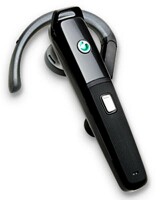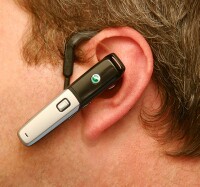
One size never fits all, but in the case of the Sony Ericsson HBH-610a Bluetooth Headset, one size fits few. Namely, it seems Sony has concocted a nice product that fits only small ears on small sized heads, but claims to be ergonomic. Quote: An ergonomic ear hook combined with low weight enable you to wear the headset all day long, staying truly handsfree.
Rubbish. Ergonomic or not, it doesnt fit my ears. Im no giant, jolly green or otherwise, although Im blessed with a generously sized hat holder. The HBH-610as ear hook is simply too small to loop over my ear and position the headsets speaker in the right place. When I force it around my ear, the little speaker wont line up with my ear canal, which of course it has to do for best volume. When I force the speaker into the right place the devices mic tries to point straight up. Looks like the designers need some remedial study of Grays Anatomy - the book, not the television series.
Oh, how I suffered to make this review. The result of all this forcing made the headset uncomfortable to wear. To make sure I wasnt just doing something wrong, I enlisted a friend to try the headset on for size. He had the same problem, but with some finagling it finally worked - hes smaller than me.

The picture shows the headset in place on his ear. The device offers no adjustments, no way to correct the position of the ear hook for larger heads and ears.
The companys claims of ergonomic design notwithstanding, I proclaim the otherwise great product is useful only if your head is much smaller than mine. Most of the women I know would love it.
In fact, I see lots of people - they might not be giants who probably would never notice the problem. Maybe the product name should include petite or some other indication of its limitations. Frankly, I expected better from the likes of Sony Ericsson, considering their experience and their exalted position in the world of wireless.
Other than the physical non-adjustable size factor, the HBH-610a headset easily lives up to my expectations. It has great incoming and outgoing sound quality, and it sports a user interface that is wonderfully simple and intuitive, especially if youve ever set up and used a Bluetooth headset.
Usability
The HBH-610a looks great, right out of the box. It also comes with two extra faceplates with which you can change it from all black to black and matte silver, to black and textured silver. The panels are simple and intuitive to switch, requiring only a fingernail and a little patience.
Another nice feature of the HBH-610a is its talk and battery times. The company estimates 6.5 hours and 300 hours, respectively. As Bluetooth headsets go, thats quite good, and Sony achieves this in a small, light weight three-quarters-ounce - package thats way easy on the eye.
The HBH-610a comes with a charging cable (wall current only, no car charger included) that hooks up to the back of the device. The connection is a little tricky to make, as the cable must be rocked into place. Removing it is a little troublesome till you get the hang of the way the connector releases. Although this makes the cable unlikely to come loose during a charge, I cant think of any reason for this connection to be so secure. You wont be wearing the headset while it charges again with the ergonomics because the charging cable hooks to the underside of the device. Youd have to route it through your head to talk and charge simultaneously.
The connector on the headset stays open to the air, where it could (and probably will) admit dirt, dust, air pollution, coffee, and whatever else you wouldnt normally want to invade such a connector. A tiny rubber cover, like the one on the LG Style-I, (Review | Buy) tethered so it wont get lost, would make a simple solution.
Documentation
The manual comes gathered in an impressive pile in the bottom of the retail box. Actually, you get several versions of the manual, each in several languages. A hefty booklet, printed in even smaller type, anchors the bottom of the stack. It contains the usual FCC (and CE and whatever else) warnings about RF interference, plus plenty of disclaimer legalese that may or may not make sense to anyone on the planet. All this in a veritable Babels Tower of languages and alphabets. Nice font.
My main beef with the documentation is that it depends too much on pictures to tell some of the story. For example, how to reset the headset. The wordless pictures require study to decide what youre being directed to do. A few actual words would help greatly. The whole thing is printed on two sides of a single sheet of thin paper that folds like a map. You know: fold, fold, cuss, unfold, fold, cuss, unfold, cuss
.
Echo and noise canceling
Bluetooth headset veterans know about echo. You hear yourself repeating everything you say. So does the person on the other end of the conversation. Sony has that well under control with the HBH-610a. Theres almost none of it, and I tested it in a worse-case situation, calling one phone with another one in the same room.
The headsets noise cancellation feature also performs admirably. Its not perfect, but it transmits a much cleaner voice to your caller than youd otherwise get, especially if you make or take calls in a noisy environment.
Indeed, when you move into a noisy area, the headsets volume automatically ramps up. Nice. Used with Sony model phones, it automatically pairs. Too bad that feature couldnt be implemented on Treos. However, the Bluetooth it speaks is version 2.0.
For pairing instructions that are simpler to read than the included paper documentation, check out this HBH-610a Web page. The device is easy to pair with your Treo, because it automatically puts itself into pairing mode the first time its turned on. Someones done their homework on this one. Brilliant.
Next Page: Conclusion >>